Wren and Martin Summary: Prepositions | Verbal Ability & Reading Comprehension (VARC) - CAT PDF Download
What is a Preposition?
- A preposition is a part of speech in English grammar that is a word or set of words that indicates the location or some other relationship between a noun or pronoun and other parts of a sentence.
- A preposition shows the relationship between a word in the sentence and the word that is the object of the preposition. Prepositions are known as “the biggest little words” in English because of their important functions.
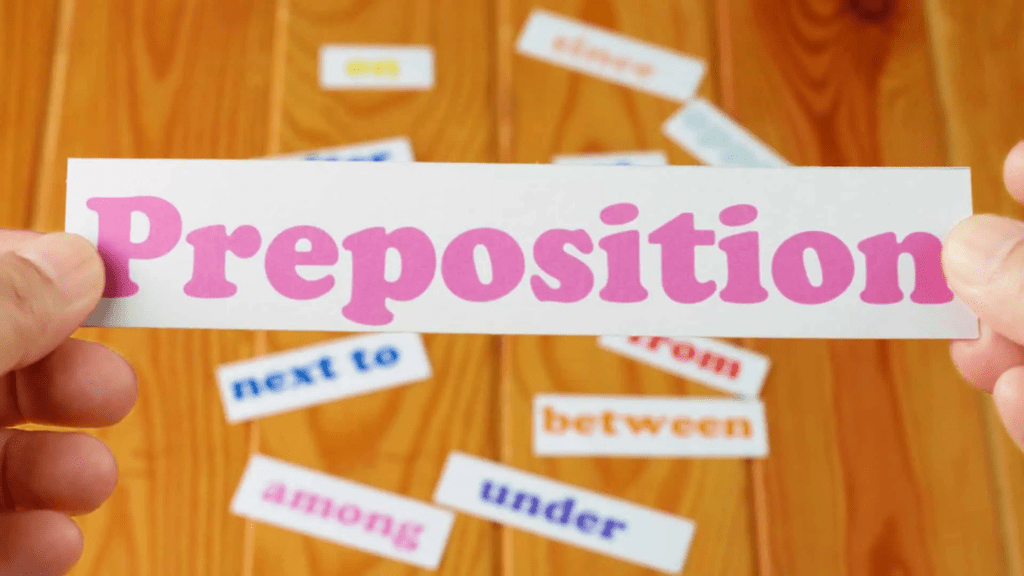
Key Features of Prepositions
Object of a Preposition: The noun or pronoun that follows a preposition is called its object. For example, in in the field, "field" is the object of "in."
Position: Prepositions usually come before their object, but sometimes they come after, especially in questions or with relative pronouns.
- What are you looking at? ("At" comes after "looking.")
- Here is the watch you asked for. ("For" is at the end.)
Multiple Objects: A preposition can have more than one object.
- The road runs over hill and plain. ("Hill and plain" are both objects of "over.")
Types of Prepositions
- Simple Prepositions:
- Single words like at, by, for, from, in, of, off, on, to, with.
- Example: She sat on the table.
- Compound Prepositions:
- Formed by combining words, like about, across, before, behind, within.
- Example: He walked across the bridge.
- Phrase Prepositions:
- Groups of words that work as one preposition, like in spite of, on behalf of, for the sake of.
- Example: He succeeded for the sake of his family.
Special Uses
- Preposition vs. Adverb: Some words can be prepositions or adverbs depending on how they’re used.
- Preposition: He jumped off the car. ("Off" has an object: "car.")
- Adverb: The car drove off. (No object, just describes the action.)
- Omitted Prepositions: Sometimes prepositions like for, from, in, onare left out before nouns of place or time.
- I’ll see you next week. (No "on" before "next week.")
- Participial Prepositions: Words like concerning, considering, and regarding act as prepositions even though they look like verbs.
- Concerning your question, I’ll answer later.
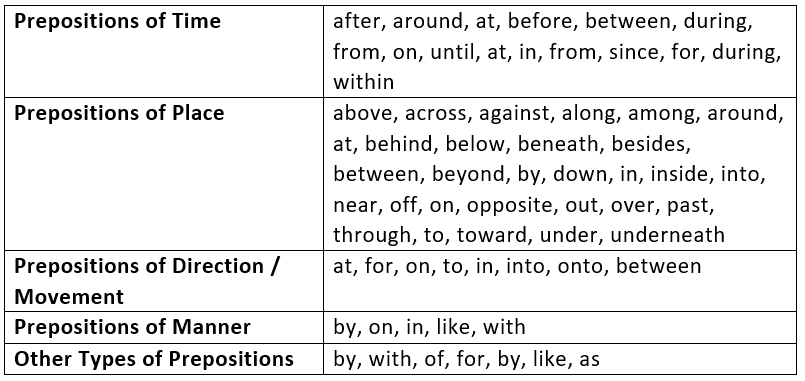
Common Relationships Shown by Prepositions
- Place: across, at, in, on, under (e.g., The book is on the table.)
- Time: after, at, before, during (e.g., We’ll meet at 5 p.m.)
- Cause: because of, due to (e.g., He left because of the rain.)
- Manner: with, by (e.g., She wrote with a pen.)
Common Mistakes
Don’t add unnecessary prepositions:
- Wrong: Where are you going to?
- Correct: Where are you going?
Some verbs don’t need prepositions:
- Correct: We discussed the plan.
- Wrong: We discussed about the plan.
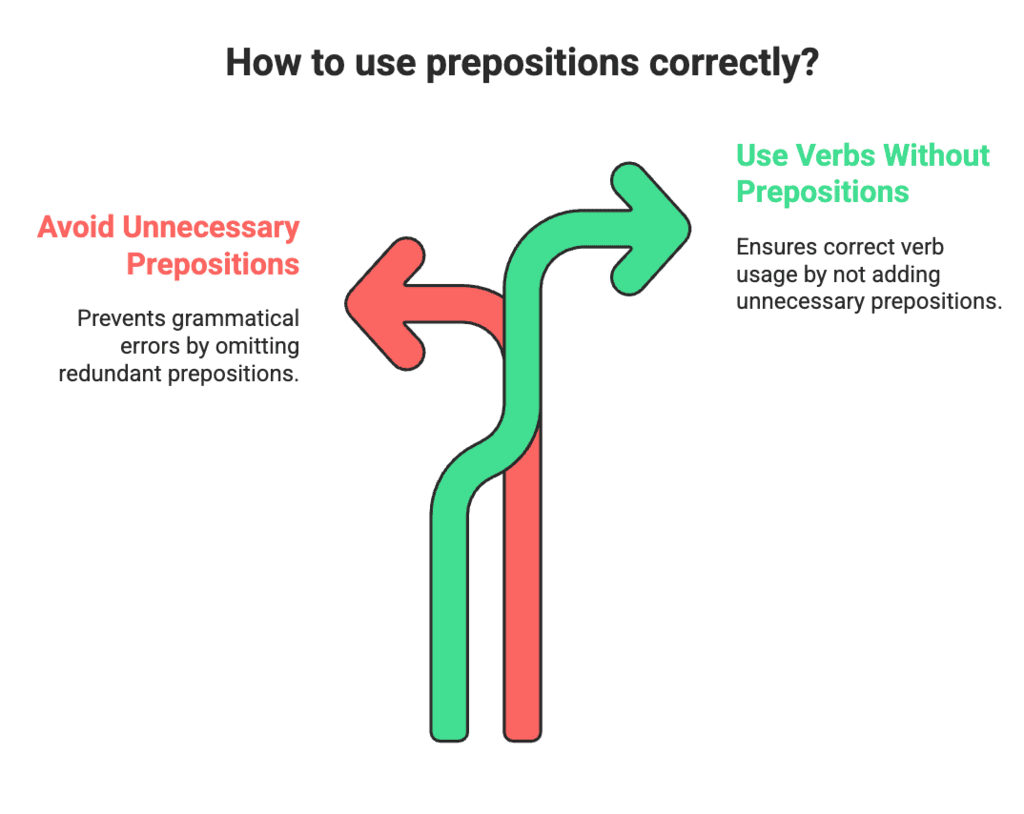
Examples in Sentences
- Little Jack Horner sat in a corner. ("In" governs "corner.")
- The cat jumped off the chair. ("Off" governs "chair.")
- He worked from morn till night. ("From" and "till" govern "morn" and "night.")
Words Followed by Prepositions
What Are Words Followed by Prepositions?
- Some verbs, nouns, adjectives, and participles always pair with specific prepositions to make sense.
- The right preposition depends on the word and its meaning in the sentence.
- Examples:
- Mumbai is famous for its textiles. ("Famous" needs "for.")
- He is fond of children. ("Fond" needs "of.")
Key Points
- Different words need different prepositions.
- The same word might take different prepositions depending on the context, changing the meaning.
- Confident of winning (sure of success) vs. Confident in his skills (trust in ability).
- Some words don’t need a preposition at all (e.g., discuss, not discuss about).
Examples by Word Type
- Nouns + Prepositions:
- Affection for: She has affection for her dog.
- Desire for: He has a desire for peace.
- Adjectives + Prepositions:
- Accustomed to: I’m accustomed to waking up early.
- Anxious about: She’s anxious about her exams.
- Verbs + Prepositions:
- Agree with: I agree with your idea.
- Differ from: This book differs from that one.
Special Cases
Changing Meaning: The preposition can change the meaning of the word.
- Look after (take care of) vs. Look for (search for).
Gerunds After Prepositions: Some words need a preposition followed by an "-ing" verb (gerund), not an infinitive.
- Correct: He is fond of swimming.
- Wrong: He is fond to swim.
Common Mistakes
Using the wrong preposition:
- Wrong: Addicted with drugs.
- Correct: Addicted to drugs.
Adding extra prepositions:
- Wrong: Order for tea.
- Correct: Order tea.
Examples in Sentences
- He is famous for his kindness. ("For" pairs with "famous.")
- She excels in dancing. ("In" pairs with "excels.")
- I’m tired of waiting. ("Of" pairs with "tired.")
Why It Matters
Using the correct preposition makes your meaning clear and your English sound natural.
Rules of Prepositions
Rule 1: A Preposition must have an object.
A preposition is not a preposition unless it goes with a related noun or a pronoun that is the object of the preposition. A preposition is always with an object – without an object, it is an adverb that never has an object.
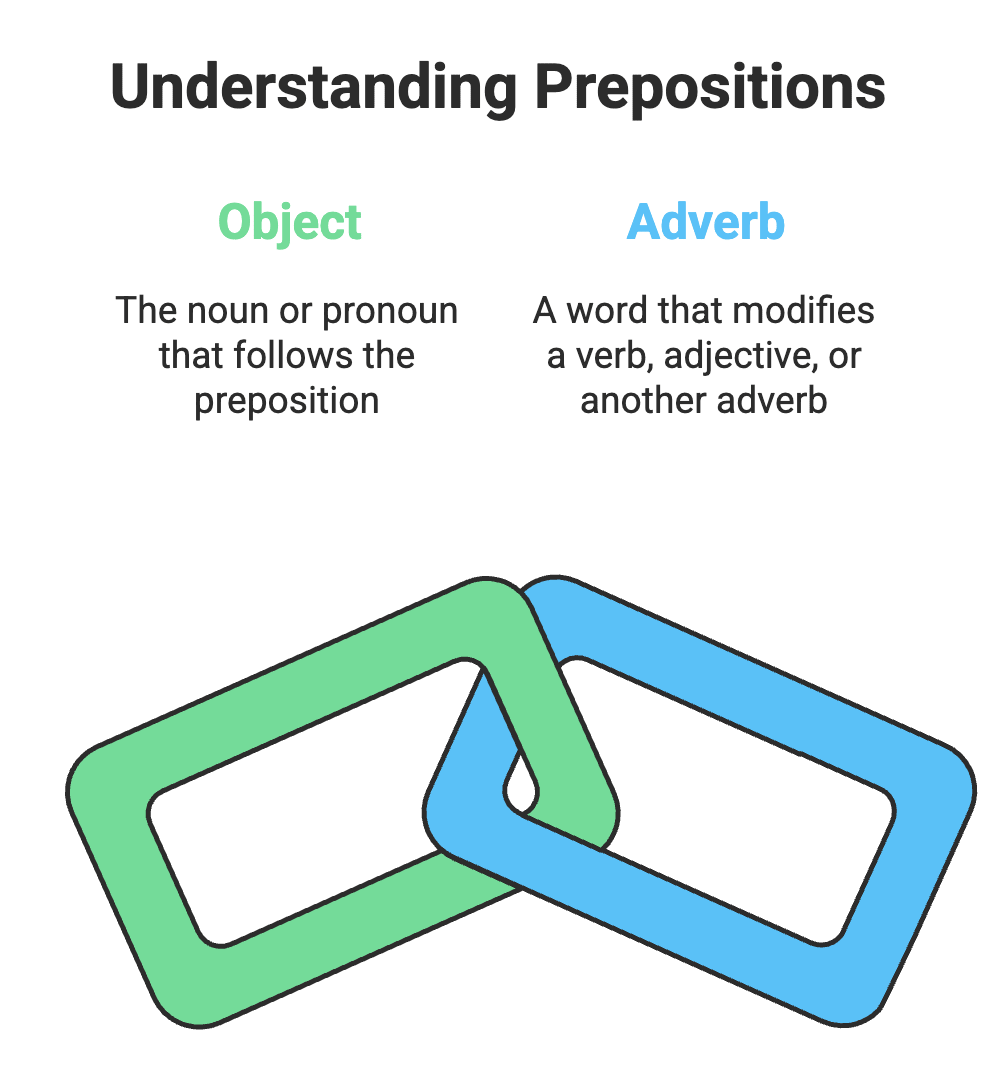
Examples:
- He is inthe kitchen. (preposition ‘in’ has object the kitchen)
- You may come in. (adverb ‘in’ has no object; it qualifies come)
- There was a car before me. (preposition ‘before’ has object ‘me’)
- Ram has never seen it before. (adverb ‘before’ has no object; it qualifies seen)
- We will catch up after the gym. (preposition ‘after’ has object ‘gym’)
- They called soon after. (adverb ‘after’ has no object; it qualifies ‘called’)
Rule 2: Must be placed before – As the name says ‘Pre-Position’ – it comes before something. Generally, but not always, a preposition goes before a noun or a pronoun. Example:
- I put the things in the box. (‘in’ is placed before the noun ‘’box’)
 View Answer
View Answer 
Note: You do not end a sentence with a preposition is one of the undying myths of English Grammar because even when a preposition is not placed before its object, it is closely related to its object.
Example:
Whom did you talk to? (Preposition ‘to’ related to the pronoun ‘Whom’)
Rule 3: The Pronoun following the Preposition should be an object form.
The noun or pronoun following a preposition forms a prepositional object. If a pronoun is following a preposition, it should be in the objective form ( me, her, them) and not the subjective form like (I, she, they, etc.).
Examples:
- The gift was from them. (preposition ‘from’ followed by the objective pronoun ‘them’)
- The secret is between him and her. (preposition ‘between’ followed by the objective pronoun ‘him’)
Rule 4(A): Avoid ‘like’ when a verb is involved.
The preposition ‘like’ that means “similar to” should be followed by a noun, pronoun, noun phrase as an object of the preposition. A subject or a verb should not follow the preposition ‘like’.
Examples:
- Correct – She looks like her mother. (noun ‘mother’ is the object of the preposition ‘like’)
- Incorrect – She looks like her mother does. (avoid ‘like’ with noun + verb)
Rule 4(B): When there is a comparison between a subject or verb, instead of like, use as, as if, as though, or ‘the way’.
Examples:
- Incorrect: She looks like her mother does.
- Correct: She looks the way her mother does.
- Incorrect: Do like he asks.
- Correct: Do as he asks.
- Incorrect: She looks like she is angry.
- Correct: She looks as if she is angry.
Rule 4(C): Unless there is a verb involved, do not use ‘as’. ‘As’ means “in the same manner” so avoid using the preposition ‘as’ if the verb is not involved.
Examples:
- Incorrect: I, as most people, try to use good words in English.
- Correct: I, as most people do, try to use good words in English. Or I, like most people, try to use good words in English.
Rule 5: Do not confuse the preposition ‘to’ with infinitive ‘to’.
‘To’ is an infinitive participle (to sing, to dance, etc.) as well as a preposition too like (to me, to Moscow, etc.).
Examples:
- ‘To’ as a Preposition:
I am used to swimming.
I look forward to seeing you. (not ‘see you’)- ‘To’ as an Infinitive Participle:
I used to live in Australia.
They love to dance.
Rule 6: Some words that look like verbs follow the preposition ‘to’. A Verb cannot be an object of a preposition. This rule of preposition may seem confusing, so let us understand with examples.
Examples:
- I like to swim.
- These goggles are for swimming.
- In these examples, “swim” and “swimming” are not acting as verbs.
- In the first example, to swim is part of the infinitive that occurs when a verb is used as a noun, adverb or adjective. Here, to swim is a thing that the person likes doing, not an action that is being performed.
- In the second example, swimming is a gerund which is a noun though it is formed out of a verb. Here, swimming is a thing to which goggles are related. No one in this sentence is performing the act of swimming.
Rule 7: Do not confuse the preposition ‘In’ and ‘Into’.
This rule of preposition says, use “into” to express motion toward something and reserve the preposition “in” when you want to indicate a location.
Examples:
- I swam in the pool. (Indicating location)
- Look in the almirah. (Indicating location)
- The cat jumped into the well. (Expressing motion)
- He drove into the city. (Expressing motion)
Use and Examples of Some Important Prepositions
1. At/In/On
In reference to ‘Time’
- At is used for a precise time.
- In is used for months, years, centuries and long periods.
- On is used for days and dates.
In reference to ‘Place’
- At is used for a point.
- In is used for an enclosed space.
- On is used for a surface.
(i) At shows stationary position or existing state while In shows movement.
Examples:
- She is at home.
- The train is in motion.
(ii) At for small place, town etc. while In for big place, town, city, country etc.
Examples:
- He lives at Alwar in Rajasthan.
- A temple is situated at Madurai in Chennai.
(iii) At is used for a Point of time, and In is used for a Period of time.
Examples:
- The train will arrive at six in the morning.
- He will meet you in the morning.
(iv) In/Into In shows the existing state of things, while Into shows movement.
Examples:
- He jumped into the river.
- There are three students in the class.
Some other common uses of At/On/In
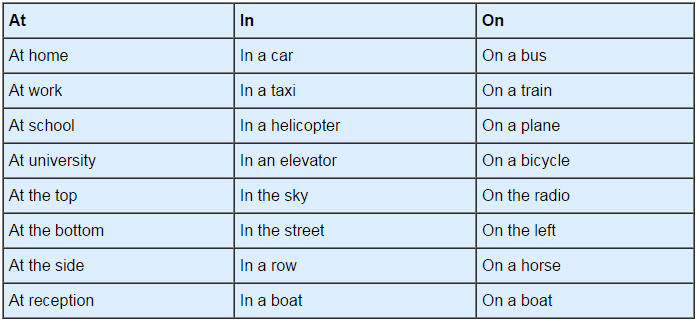
2. To/Into
- In the direction of: Turn to the right.
- Destination: I am going to Jaipur.
- Until From: Monday to Friday; five minutes to ten
- Compared with: They prefer hockey to soccer.
- With indirect object: Please give it to me.
- As part of the infinitive: I like to ski; he wants to help.
- In order to: We went to the store to buy soap.
- To the inside of: We stepped into the room.
- Change of condition: The boy changed into a man.
3. On/Onto
(i) On can be used for both existing position and movement.
Examples:
- He was sitting on his bag.
- Snow fell on the hills.
(ii) On can also be used as an adverb
Examples:
- Go on.
- Come on.
(iii) Onto is used when there is a movement involving a change of level.
Examples:
- People climbed onto their roofs.
- He lifted her onto the table.
4. With/By
With is used for instruments, and By is used for agents.
Examples:
- The snake was killed by him with a stick.
- The letter was written by Suresh with a pencil.
5. Since/For/From
i) Since is often used with Present Perfect or Past Perfect Tense
Examples:
- It has been raining since two O’Clock.
- He had been ill since Monday.
(ii) Since can also be used as an adverb
Examples:
- He left school in 1983. I haven’t seen him since.
- It is two years since I last saw Tom.
6. Beside/Besides
Beside and Besides have altogether different meanings.
Don’t confuse beside with besides.
(i) beside = at the side of
Example: He was sitting beside Sarla.
(ii) besides = in addition to / as well as
Example: He has a car besides a motorcycle.
7. Between/Among
(i) Between is normally used for ‘two things or persons, but it can also be used more when we have a definite number in mind and there is a close relationship/ association within them.
Examples: He distributed his property between his two daughters.
(ii) Among is usually used for more than two persons or things when we have no definite number in mind.
Example: He was happy to be among friends again.
8. Among/Amongst
Both have the same meaning. Either of them can be used if followed by 'the'. If followed by a word, beginning with a vowel 'amongst' be used.
Examples:
- He distributed the toffees among/amongst the poor.
- He distributed the toffees amongst us.
9. More Prepositions
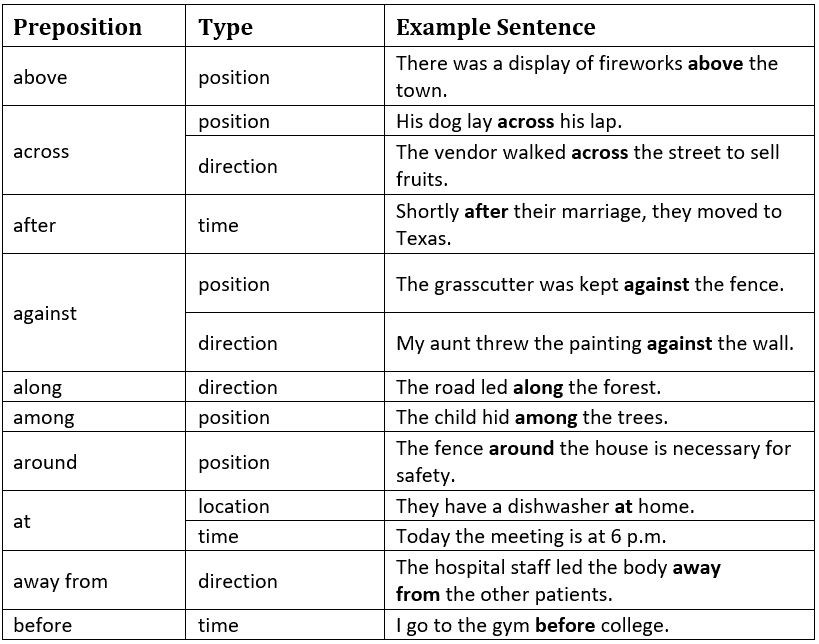
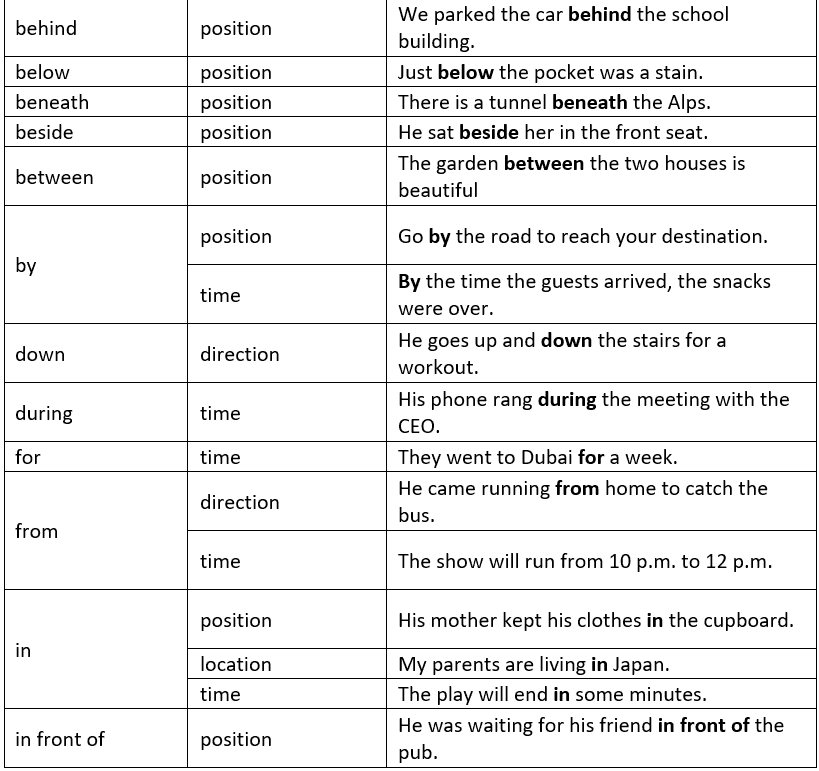
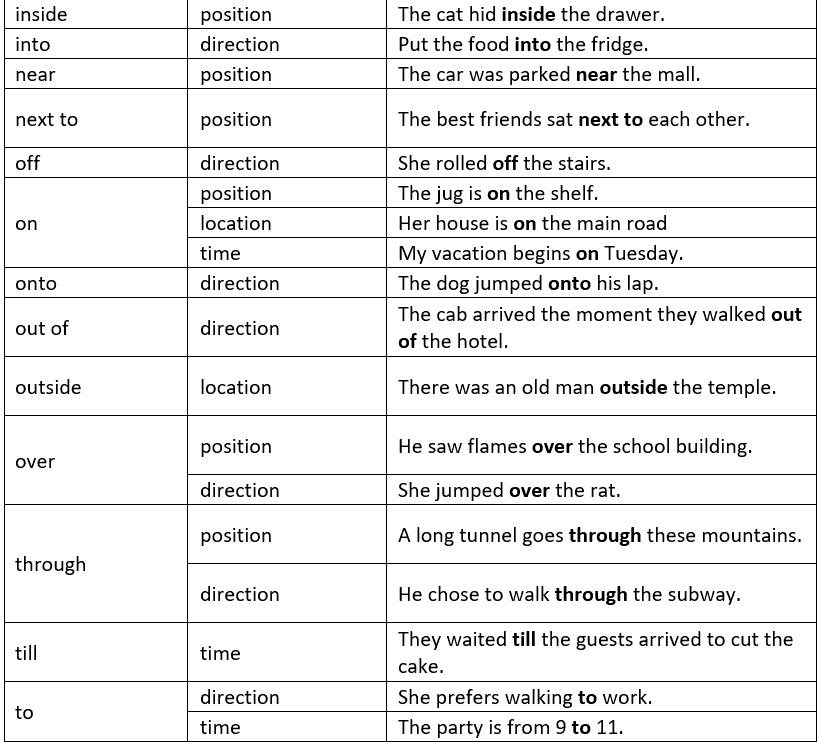
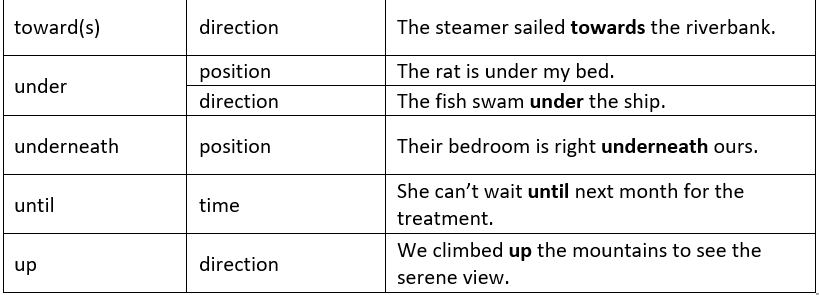
|
111 videos|450 docs|90 tests
|
FAQs on Wren and Martin Summary: Prepositions - Verbal Ability & Reading Comprehension (VARC) - CAT
| 1. What is a preposition? |  |
| 2. What are the types of prepositions? |  |
| 3. What are the rules of prepositions? |  |
| 4. How are prepositions used in sentences? |  |
| 5. Can you provide some examples of important prepositions? |  |

















